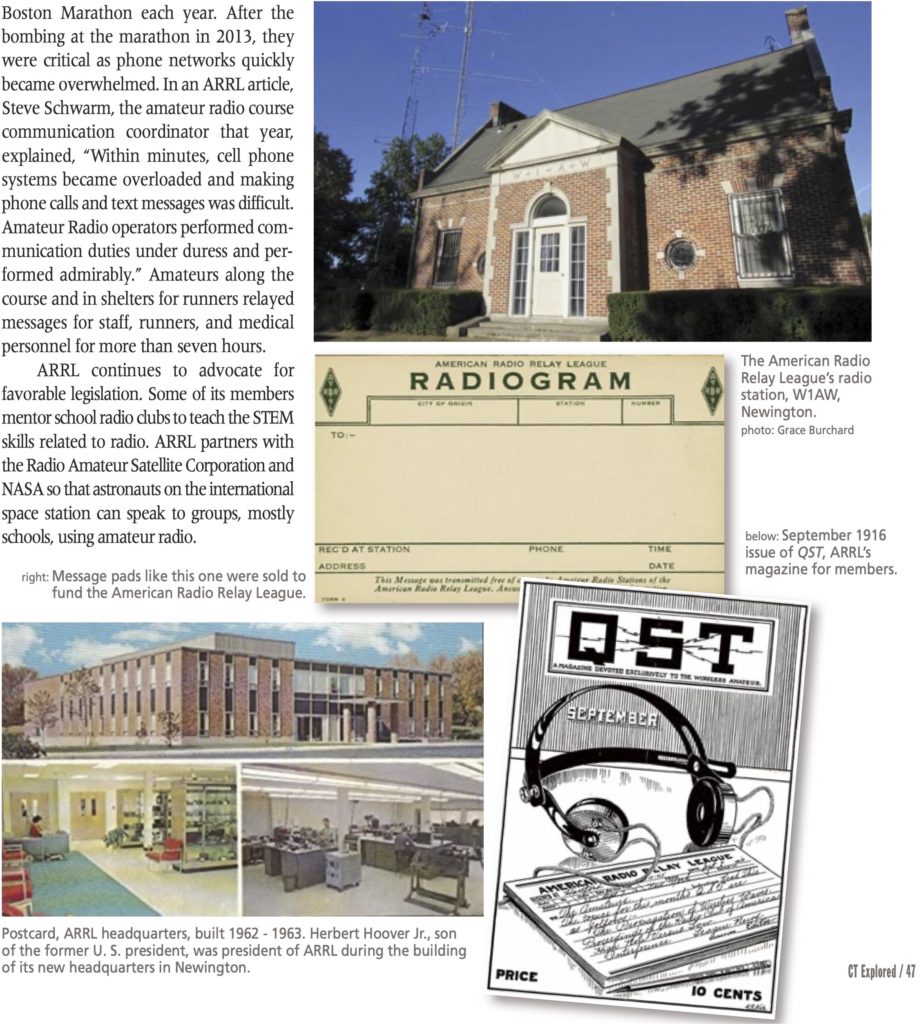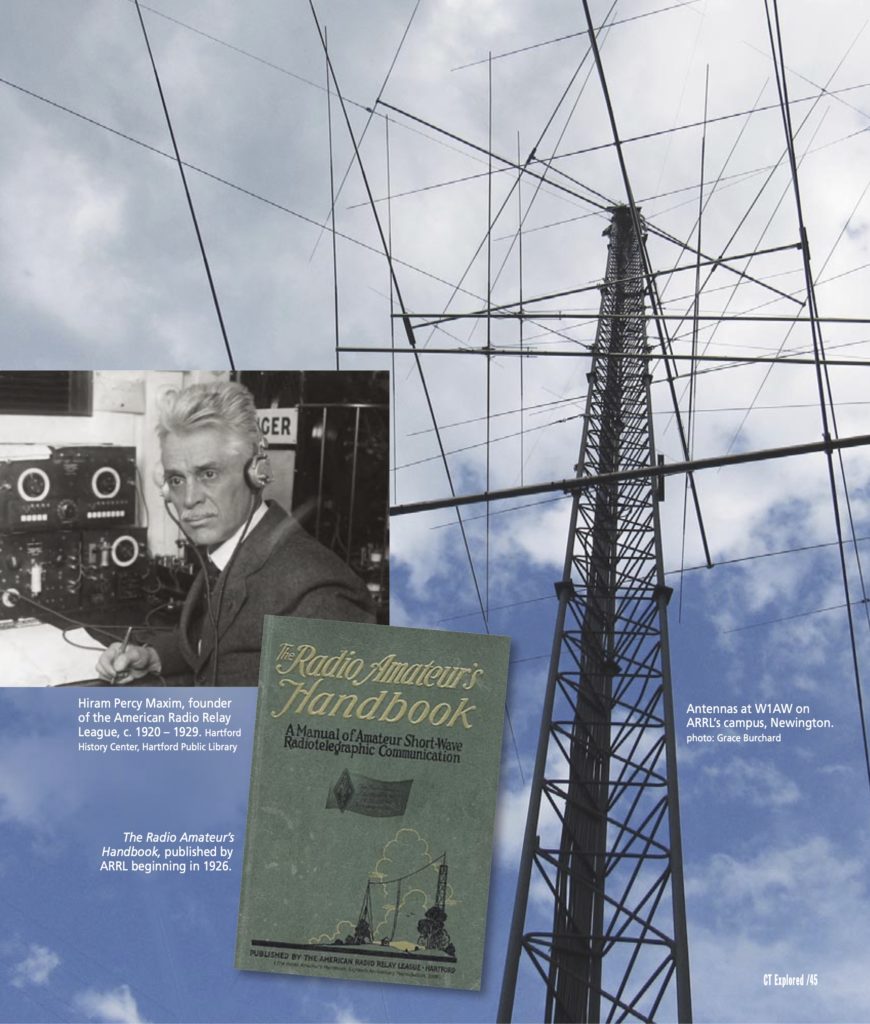(c) Connecticut Explored Inc. Winter 2020-2021
Subscribe/Buy the Issue!
Have you ever seen a car or truck with yard-long antennas on the roof? Have you passed a house with a large antenna or wires strung horizontally between trees? Chances are, these were passing encounters with amateur radio.
In amateur radio, licensed operators use federally allocated frequencies for personal, non-commercial purposes. Some “hams,” as operators are nicknamed, enjoy the technical challenge of building or perfecting their equipment. Others compete in contests, making as many contacts as possible within a limited time, sometimes with battery-powered transceivers and portable antennas. Some enjoy making long-distance contacts or simply chatting with other amateurs.
Connecticut’s amateur radio activity began in the early days of radio. As early as 1906, amateurs could communicate by voice with newer innovations in equipment, instead of the “dits” and “dahs” (short and long signals) of Morse code. Wireless clubs sprang up across America, including the Hartford Radio Club, founded on January 19, 1914.
Businesses began to employ radio. The U.S. Navy, seeing its value for ship-to-ship or ship-to-shore communication, was one of the earliest organizations to heavily invest in and use radio. But this soon led to conflict on the airwaves. Amateurs seeking the best performance bought or built better equipment than standard navy issue, and early amateurs far outnumbered other operators. Official stations sometimes had to request that amateurs cease transmitting so that they could conduct their business.
Amateurs, though, contended they had as much right to use the airwaves as the U.S. Navy or any other organization. Clinton B. DeSoto, in Two Hundred Meters and Down: The Story of Amateur Radio (American Radio Relay League, 1936), notes that initially, “many of them had better and more powerful stations than those used by the Navy and commercial services, and their indifference to the pleas of these operators to cease operating when there was murderous interference was sublime.” No regulations existed until the U.S. Congress passed the Radio Act of 1912 to address the problem. The act limited amateur radio users to the frequencies that were least useful to military and commercial stations.
Radio users had discovered that longer wavelengths travel farther than short wavelengths. Think of lower-frequency radio signals with long wavelengths as being like gentle ocean swells that are longer in length and farther apart. They tend to travel farther, and some very low frequencies can bend slightly to follow the curvature of the earth. Higher frequency radio signals, on the other hand, are like choppy short waves, and many more fit into the same space that one long wave would take up. Higher-frequency signals cannot travel as far and can be blocked by hills or buildings. As such, they are sometimes described as “line-of-sight” communication.
In order to accurately receive radio signals, an antenna should ideally match, or be a fraction of, the wavelength of the frequency. Naval ship size limited the antennas to between 450 and 600 meters, ideal for longer wavelengths and long-distance communication. DeSoto describes the legislators’ motives and imagined conversation as: “We will give amateurs this useless wavelength of 200 meters. That will reduce the amateur to oblivion as surely as another way, quoth they; for who will work long in a worthless territory?” The bill also limited amateurs’ transmission power and required licensing by the U.S. Department of Commerce.
Despite the new restrictions, amateurs continued transmitting, using 200 meters and below. In March 1914 Hiram Percy Maxim, chair of the Hartford Radio Club, wanted to reach a fellow amateur in Springfield, Massachusetts, but geography made it impossible. An amateur in Windsor Locks, Connecticut, located between Hartford and Springfield, could easily communicate with both cities, and Maxim enlisted his help. This transaction spurred an idea. Maxim had hoped for a national amateur league, but it would need a foundational purpose. Previous organizations had failed, being merely ceremonial groups in which anyone could enroll for free and get a fancy certificate.
In April Maxim proposed that the Hartford Radio Club found the American Radio Relay League (ARRL). As The Hartford Courant explained in an October 13, 1914 article, “The American Radio Relay League was formed for the purpose of the sending of messages for long distances by amateurs using the proper apparatus and obeying governmental regulations.” Membership was free, but requirements ensured that only qualified amateurs would operate relay stations. DeSoto notes that “by June, successful relays had been accomplished over such routes as Hartford to Buffalo. A route from Boston to Denver was being organized.” By October, The Courant story announced, “Radio operators are active here: air is laden with messages, chiefly at night. League booklet just published: shows list of relay stations in U.S. and Canada.” The ARRL booklet listed 382 relay stations for amateur use, and included operating hours, range, and transmitting power for each station. ARRL also sold pads of 50 message blanks used to write down messages for 50 cents as a source of revenue for the organization.
Maxim met with the Department of Commerce in Washington. He introduced the league and petitioned for special licenses allowing certain stations to operate on the 425-meter wavelength for message relay only. This would fill in “gaps” in some routes. With this new option, amateurs, using the ARRL directory, could send messages for free over distances which had previously been prohibitively expensive by other means.
In February 1915 the ARRL formally separated from the Hartford Radio Club and began requesting a donation of 50 cents per year for station dues. In December it began publishing a magazine by subscription for $1 per year, titled QST, a three-letter code for “general call to all stations. (Long before the first “lol” was sent by cell-phone text, radio operators had a variety of abbreviations and three-letter codes to send messages faster.)
 In fall 1915, two years into World War I, the ARRL collaborated with the Naval Radio Service to create ways for amateurs to assist in time of war. But in April 1917 the government issued a moratorium forbidding amateurs to operate, and all antennas had to be lowered to the ground. At the same time, the military desperately needed skilled radio operators, and thousands of amateurs volunteered. While inexperienced soldiers might require as many as 16 weeks of training, amateurs needed only 100 hours.
In fall 1915, two years into World War I, the ARRL collaborated with the Naval Radio Service to create ways for amateurs to assist in time of war. But in April 1917 the government issued a moratorium forbidding amateurs to operate, and all antennas had to be lowered to the ground. At the same time, the military desperately needed skilled radio operators, and thousands of amateurs volunteered. While inexperienced soldiers might require as many as 16 weeks of training, amateurs needed only 100 hours.
After the 1918 Armistice amateurs returned home, still forbidden to use their own radios. In 1917 and 1919, legislation proposed giving the U.S. Navy control over all radio. In 1917 Maxim lobbied Congress to vote against the measure, and two years later ARRL asked its members to write to Congress. Thousands of letters poured in, showing ARRL’s power as a national organization. The legislation failed. In September 1919 amateurs were finally permitted to transmit again. Later laws expanded amateur rights, and 1934 legislation established the Federal Communications Commission, which today licenses amateurs.
A 1921 trans-continental relay test proved amateur radio was the fastest known method of communication: 6 ½ minutes to send and return a message. People all over the country celebrated. Mayors and organizations sent greetings, including one from TheHartford Courant to the Los Angeles Times. When conditions are right, transmissions can be heard across astonishing distances. On December 15, 1919, The Hartford Courant published a short account of “a night of remarkable wireless operations.” Maxim was quoted as saying, “My station was talking with Chicago for over an hour tonight. We could hear Chicago relaying our messages to Topeka, Kansas and then—most remarkable of all—we heard the Kansas station relaying our messages to Roswell, N. M.” Unheard by Maxim, the New Mexico station transmitted to Los Angeles, 3,000 miles from Hartford.
That same year, American amateurs started reaching other countries, with better equipment and by using shortwave: 100 meters—a frequency that should have been worse than the “useless” 200 meters allocated to amateurs. Now You’re Talking: All You Need to Get Your First Ham Radio License (ARRL, 1997), explains this phenomenon known as “skip” or “skywave propagation”: UV solar radiation absorbed by gas atoms in the upper atmosphere causes the atoms to lose electrons. “When ionized by solar radiation, this region, called the ionosphere, can refract (bend) radio waves. If the wave is bent enough, it returns to Earth. … Ham radio contacts of up to 2500 miles are possible with one skip off the atmosphere.” Soon amateurs were “chatting” across previously unimaginable distances, joining what was becoming an international hobby. In 1924 Maxim attended the first meeting of the International Amateur Radio Union in Paris, representing American amateurs among Europeans with similar interests.
Today ARRL emphasizes five pillars: public service, advocacy, education, technology, and membership. Public service is the goal of ARRL’s Amateur Radio Emergency Service (ARES). Amateurs involved in ARES register their equipment to serve in natural disasters or emergencies. Many undergo advanced training and ensure they can operate off-grid. Working with police and emergency personnel, they relay official messages. Many amateurs volunteer at public events. At least 200 amateurs help along the route of the Boston Marathon each year. After the bombing at the marathon in 2013, they were critical as phone networks quickly became overwhelmed. In an ARRL article, Steve Schwarm, the amateur radio course communication coordinator that year, explained that, “Within minutes, cell phone systems became overloaded and making phone calls and text messages was difficult. Amateur Radio operators performed communication duties under duress and performed admirably.” Amateurs along the course and in shelters for runners relayed messages for staff, runners, and medical personnel for more than 7 hours.
ARRL continues to advocate for favorable legislation. Some of its members mentor school radio clubs to teach the STEM skills related to radio. ARRL partners with the Radio Amateur Satellite Corporation and NASA so that astronauts on the international space station can speak to groups, mostly schools, using amateur radio.
Hiram Percy Maxim’s call sign 1AW is incorporated into the radio station W1AW at the ARRL headquarters in Newington. Any licensed amateur can visit the W1AW studio and use the equipment. Everyone is welcome to tour the building and learn more about amateur radio. Amateurs worldwide still enjoy chatting, experimenting, and welcoming new members to their wireless community.
Grace Burchard is a library technical assistant for the Connecticut State Library. She is a licensed radio amateur and a member of the American Radio Relay League.
This story is one in a series of stories funded in part by Hartford Foundation for Public Giving about the history of nonprofits that operate in the Greater Hartford region.
EXPLORE!
Read more about Hiram Percy Maxim in “The Miracle on Capital Avenue,” May/Jun/Jul 2004, and “The Horseless Era Arrives,” Spring 2005.
GO TO NEXT STORY


